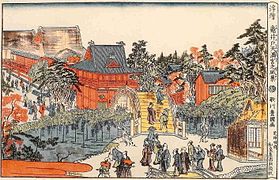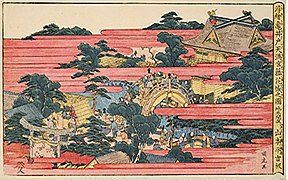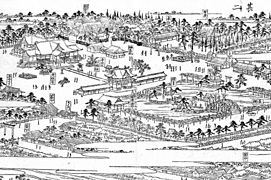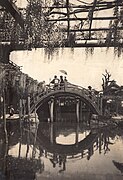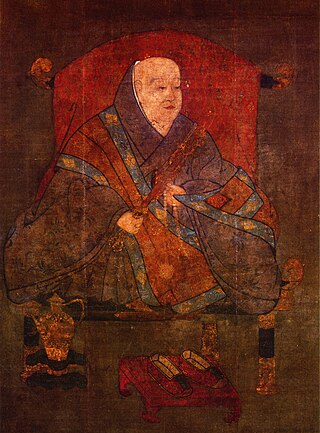
Emperor Uda was the 59th emperor of Japan, according to the traditional order of succession.

Ōta Dōkan, also known as Ōta Sukenaga, was a Japanese samurai lord, poet and Buddhist monk. He took the tonsure as a Buddhist priest in 1478, and he also adopted the Buddhist name, Dōkan, by which he is known today. Dōkan is best known as the architect and builder of Edo Castle in what is today modern Tokyo; and he is considered the founder of the castle town which grew up around that Ōnin era fortress.

Edo Castle is a flatland castle that was built in 1457 by Ōta Dōkan in Edo, Toshima District, Musashi Province. In modern times it is part of the Tokyo Imperial Palace in Chiyoda, Tokyo, and is therefore also known as Chiyoda Castle. Tokugawa Ieyasu established the Tokugawa shogunate there, and it was the residence of the shōgun and the headquarters of the military government during the Edo period (1603–1867) in Japanese history. After the resignation of the shōgun and the Meiji Restoration, it became the Tokyo Imperial Palace. Some moats, walls and ramparts of the castle survive to this day. However, the grounds were more extensive during the Edo period, with Tokyo Station and the Marunouchi section of the city lying within the outermost moat. It also encompassed Kitanomaru Park, the Nippon Budokan Hall and other current landmarks of the surrounding area.
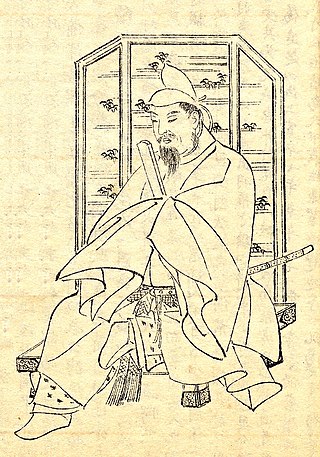
Sugawara no Michizane was a scholar, poet, and politician of the Heian Period of Japan. He is regarded as an excellent poet, particularly in waka and kanshi poetry, and is today revered in Shinto as the god of learning, Tenman-Tenjin. In the poem anthology Hyakunin Isshu, he is known as Kanke (菅家), and in kabuki drama he is known as Kan Shōjō (菅丞相).

Kitano Tenmangū is a Shinto shrine in Kamigyō-ku, Kyoto, Japan.

Dazaifu Tenman-gū (太宰府天満宮) is a Shinto shrine in Dazaifu, Fukuoka Prefecture, Japan. It is built over the grave of Sugawara no Michizane (845–903) and is one of the main shrines dedicated to Tenjin, the deified form of Michizane.

In the Shinto religion of Japan, Tenjin (天神), also called Tenman Daijizai Tenjin (天満大自在天神), is the patron kami (deity) of academics, scholarship, of learning, and of the intelligentsia.

Tenmangū (天満宮) is a Shinto shrine which enshrines Sugawara no Michizane as Tenjin. There are about 14,000 such shrines in Japan; famous examples include:

Sugawara no Kiyotomo, also read as Kiyokimi, was a Japanese court noble, poet, and politician of the early Heian period. He served as Vice Minister of Ceremonial Affairs, Mayor of the Left Capital District, and Vice Governor of Harima Province (824-825), and held the court rank of Junior Third Rank.

In a broad sense, Goryō is an honorific for a spirit, especially one that causes hauntings, and the term is used as a synonym for onryō. In a narrower sense, it refers to a person who was a noble or accomplished person in his or her lifetime, but who lost a political power struggle or died prematurely from an epidemic or other disease, becoming a onyō that brings pestilence or famine and is later enshrined as a kami in Shinto shrines. For example, the "Sandai Jitsuroku" mentions that six Shinto shrines were dedicated to the worship of goryō, which were the spirits of those who died from non-natural causes. Later on, two more shrines were added, bringing the total to eight.

Kanō Tenman-gū (加納天満宮) is a Shinto shrine located in the city of Gifu, Gifu Prefecture, Japan. It was built as the shrine to protect Izumii Castle. As a Tenman-gū, it is dedicated to Tenjin, the deified form of Sugawara no Michizane. Additionally, Matsudaira Mitsushige, who first created Gifu Umbrellas, is also canonized on the shrine grounds. The shrine's festival is held on the third Saturday and Sunday of October each year.

Tenjin Beach is a recreational beach on Lake Inawashiro in Fukushima Prefecture, Japan. On August 18, 1925, Tenjin Beach was the site of the first Boy Scouts of Japan camping trip. Members of the Imperial Family, including Crown Prince Hirohito and Prince Chichibu, attended the event. In winter, strong winds and waves form natural ice sculptures on shoreline vegetation, attracting many amateur photographers to a 1 kilometer stretch of Tenjin Beach.
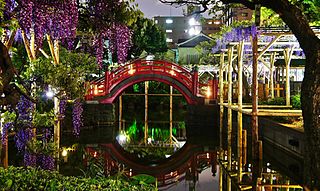
Fuji Matsuri is a Japanese wisteria festival that takes place during April and May. Places it is celebrated include Tokyo, Shizuoka, and Okazaki.
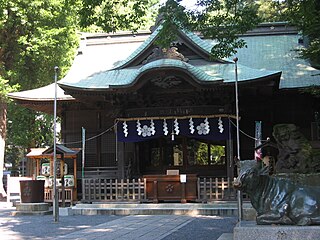
Yabo Tenman-gū (谷保天満宮) is a Shinto shrine in Kunitachi, Tokyo, Japan.

Nagara Tenjin Shrine is a Shinto shrine located in the Nagara area of Gifu, Gifu Prefecture, Japan. It is a Tenman-gū dedicated to the worship of Sugawara no Michizane.

Yushima Tenman-gū (湯島天満宮) is a Shinto shrine located in the Bunkyō ward of Tokyo, Japan.
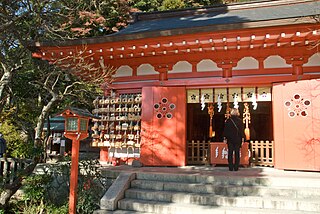
Egara Tenjin Shrine, is a Shinto shrine in Kamakura. Having been founded according to legend by an unknown priest in 1104, it is one of the few extant religious institutions in the area to predate the advent of Minamoto no Yoritomo, who arrived here in 1181. Like all other Tenjin shrines in Japan, it enshrines the spirit of famous scholar and politician Sugawara no Michizane under the name Tenjin. For this reason, the kami is believed to be a protector of intellectual pursuits.

Plum Park in Kameido is a woodblock print in the ukiyo-e genre by the Japanese artist Hiroshige. It was published in 1857 as the thirtieth print in the One Hundred Famous Views of Edo series and depicts Prunus mume trees in bloom.
Tenjin no Honji (天神の本地) is a Japanese otogi-zōshi in two scrolls, likely composed at the end of the Muromachi period.
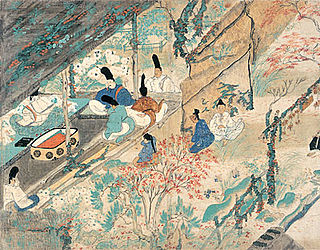
The Kitano Tenjin Engi Emaki is an emakimono or emaki from the beginning of the 13th century, in the Kamakura period of Japanese history (1185–1333). An illuminated manuscript, it narrates in eight calligraphed and painted scrolls the life of Sugawara no Michizane and the construction of the Kitano Tenmangū shrine in his honour after his death.


